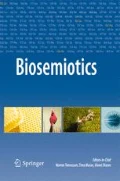Abstract
Nietzsche’s The Birth of Tragedy introduces an intriguing combination of so-called ‘drives’, seemingly biologically inspired forces behind humanity’s cultural ways of relating to what is, and extensive distrust of science. Despite the Greek mythological context, the insight and the arguments provided by Nietzsche seem relevant to contemporary biologically inspired approaches to cognition found within biosemiotics, as well as the embodied cognition paradigm. Here, I discuss how Nietzsche’s biological conception of our relation to what is, incessantly emphasises a critical approach to our predilections and mindless conventionalist beliefs.
Notes
Nietzsche alternates between different interpretations of what is meant by ‘drive’. Sometimes drives work inside of an individual and sometimes they work at the level of the species (Burnham and Jesinghausen 2010, p. 34).
Conceptualising that humans relate to the world by the notion ‘drive’ establishes the image of an irresistible impulsive power, an urge that works bottom-up (e.g. Schilhab 2017).
According to Welshon (2014, p. 13), “one of the reasons his views remain so interesting is that they skip right over the last eighty years of computationalist, internalist, and behaviourist philosophy of mind to intersect – in some cases without loss – the contemporary extended mind hypothesis and its various offshoots”.
In Being alive, Ingold never discusses Nietzsche, but refers to Augustine, Kant, Gibson, and Heidegger. Thus, it remains unclear whether Ingold has been inspired directly by Nietzsche.
Nietzsche’s sense of the natural world is not a form of ‘Naturalism’ endorsing a naive realistic ontology that reduces what is to categories and laws in the spirit of the natural sciences. According to Burnham and Jesinghausen (2010, p. 8), The Birth of Tragedy was a contribution against a naturalistic doctrine prevalent in arts and literature studies. Welshon argues (2014, p. 23), however, that Nietzsche is a naturalist in so far as he holds “that philosophy and empirical science should share the same ontology, where an ontology is the set of categories (e.g., object, property, process, event, state, and system) that an empirical view is prepared to quantify over”.
References
Babich, B. (2014). Nietzsche and/or/versus Darwin. Common Knowledge, 20(3), 404–411.
Barsalou, L. W. (2010). Grounded cognition: past, present, and future. Topics in Cognitive Science, 2(4), 716–724.
Burnham, D. (2014). Apollo and the problem of the unity of culture in the early Nietzsche. In A. K. Jensen & H. Heit (Eds.), Nietzsche as a scholar of antiquity (pp. 75–95). London: Bloomsbury.
Burnham, D., & Jesinghausen, M. (2010). Nietzsche’s The birth of tragedy. London: Continuum.
Burnham, D., & Jesinghausen, M. (2011). Of butterflies and masks. In A. Rehberg (Ed.), Nietzsche and Phenomenology (pp. 33–52). Cambridge: Cambridge Scholars.
Cobley, P., & Stjernfelt, F. (2016). Sign, object, thing. Chinese Semiotic Studies, 12(3), 329–334.
Deely, J. N. (1994). The human use of signs: Or elements of anthroposemiosis. Lanham: Rowman and Littlefield Publishers.
Gayon, J. (1999). Nietzsche and Darwin. In J. Maienschein & M. Ruse (Eds.), Biology and the foundation of ethics (pp. 154–197). Cambridge: Cambridge University Press.
Ingold, T. (1993). Tool-use, sociality and intelligence. In K. R. Gibson & T. Ingold (Eds.), Tools, language and cognition in human evolution (pp. 429–445). Cambridge: Cambridge University Press.
Ingold, T. (2011). Being alive: Essays on movement, knowledge and description. New York: Routledge.
Johnson, D. R. (2013). One hundred twenty-two years later: Reassessing the Nietzsche-Darwin relationship. The Journal of Nietzsche Studies, 44(2), 342–353.
Menary, R. (2010). Introduction to the special issue on 4E cognition. Phenomenology and the Cognitive Sciences, 9(4), 459–463.
Moore, G. (2002). Nietzsche, biology and metaphor. Cambridge: Cambridge University Press.
Nietzsche, F. W. (2006a [1872]). The birth of tragedy from the spirit of music. In K. Ansell-Pearson & D. Large (pp. 42–87). The Nietzsche Reader. Malden,: Blackwell Pub.
Nietzsche, F. W. (2006b [1873]). On truth and lies in a nonmoral sense. In K. Ansell-Pearson & D. Large (pp. 114–123). The Nietzsche Reader. Malden,: Blackwell Pub.
Nietzsche, F. W. (2006c [1874]). Schopenhauer as educator. In K. Ansell-Pearson & D. Large (pp 142–150). The Nietzsche Reader. Malden: Blackwell Pub.
Pence, C. H. (2011). Nietzsche's aesthetic critique of Darwin. History and Philosophy of the Life Sciences, 33(2), 165–190.
Pitrou, P. (2015). An anthropology beyond nature and culture? In T. Ingold and G. Palsson's (Eds.), Biosocial Becomings, Available at http://somatosphere.net/2015/08/an-anthropology-beyond-nature-and-culture-tim-ingold-and-gisli-palssons-edited-volume-biosocial-becomings.html. Accessed July 1 2017.
Schilhab, T. (2013). Derived embodiment and imaginative capacities in interactional expertise. Phenomenology and the Cognitive Sciences, 12(2), 309–325.
Schilhab, T. (2015a). Re-live and learn–Interlocutor-induced elicitation of phenomenal experiences in learning offline. Progress in Biophysics and Molecular Biology, 119(3), 649–660.
Schilhab, T. (2015b). Doubletalk–the biological and social acquisition of language. Biologically Inspired Cognitive Architectures, 13, 1–8.
Schilhab, T. (2017). Derived embodiment in abstract language. Cham: Springer.
Stern, T. (2015). Against Nietzsche's ‘Theory’ of the Drives. Journal of the American Philosophical Association, 1(1), 121–140. https://doi.org/10.1017/apa.2014.23.
Stjernfelt, F. (2002). Tractatus Hoffmeyerensis: Biosemiotics as expressed in 22 basic hypotheses. Σημειωτκή-Sign Systems Studies, 1, 337–345.
Welshon, R. (2014). Nietzsche’s dynamical metapsychology: This uncanny animal. Basingstoke: Palgrave Macmillan.
Author information
Authors and Affiliations
Corresponding author
Rights and permissions
About this article
Cite this article
Schilhab, T. Embodied cognition and science criticism: juxtaposing the early Nietzsche and Ingold’s anthropology. Biosemiotics 10, 469–476 (2017). https://doi.org/10.1007/s12304-017-9305-8
Received:
Accepted:
Published:
Issue Date:
DOI: https://doi.org/10.1007/s12304-017-9305-8

